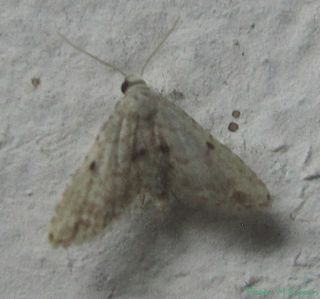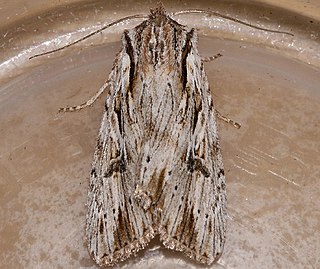
The Noctuidae, commonly known as owlet moths, cutworms or armyworms, are a family of moths. They are considered the most controversial family in the superfamily Noctuoidea because many of the clades are constantly changing, along with the other families of the Noctuoidea. It was considered the largest family in Lepidoptera for a long time, but after regrouping Lymantriinae, Catocalinae and Calpinae within the family Erebidae, the latter holds this title now. Currently, Noctuidae is the second largest family in Noctuoidea, with about 1,089 genera and 11,772 species. However, this classification is still contingent, as more changes continue to appear between Noctuidae and Erebidae.
This list contains species first discovered in Hong Kong, with the endemic species asterisked.

Nolidae is a family of moths with about 1,700 described species worldwide. They are mostly small with dull coloration, the main distinguishing feature being a silk cocoon with a vertical exit slit. The group is sometimes known as tuft moths, after the tufts of raised scales on the forewings of two subfamilies, Nolinae and Collomeninae. The larvae also tend to have muted colors and tufts of short hairs.

Noctuoidea is the superfamily of noctuid or "owlet" moths, and has more than 70,000 described species, the largest number of for any Lepidopteran superfamily. Its classification has not yet reached a satisfactory or stable state. Since the end of the 20th century, increasing availability of molecular phylogenetic data for this hugely successful radiation has led to several competing proposals for a taxonomic arrangement that correctly represents the relationships between the major lineages.

The Ophiusini are a tribe of moths in the family Erebidae.

Amphipyrinae is a subfamily of owlet moths in the family Noctuidae. There are more than 50 genera and 210 described species in Amphipyrinae, although the classifications are likely to change over time.

Diphthera festiva, the hieroglyphic moth, is a species of moth in the family Nolidae and is the only moth in its subfamily Diphtherinae. It is found in the tropical and subtropical areas of South America, Central America, North America, and the Caribbean. In North America, the species has a southeastern distribution from South Carolina west to Texas along the Gulf Coast. Strays have been recorded as far north as Michigan and Missouri. The wingspan is 37–48 mm (1.5–1.9 in). This species is occasionally considered a pest on soybeans. It was described by Johan Christian Fabricius in 1775.

Araeopteron is a genus of moths of the family Erebidae. The genus was erected by George Hampson in 1893.

Athetis is a genus of moths of the family Noctuidae. The genus was erected by Jacob Hübner in 1821.

Diphtherinae is a monotypic subfamily of moths in the family Nolidae erected by Michael Fibiger and J. Donald Lafontaine in 2005. Its only genus, Diphthera, was erected by Jacob Hübner in 1809. The genus was moved from Noctuidae in 2013 after the phylogenetic analysis of Reza Zahiri et al. (2013).
Lephana is a genus of moths of the family Erebidae. The genus was previously classified in the subfamily Calpinae of the family Noctuidae.

Parascotia is a genus of moths of the family Erebidae. The genus was erected by Jacob Hübner in 1825.

The Erebidae are a family of moths in the superfamily Noctuoidea. The family is among the largest families of moths by species count and contains a wide variety of well-known macromoth groups. The family includes the underwings (Catocala); litter moths (Herminiinae); tiger, lichen, and wasp moths (Arctiinae); tussock moths (Lymantriinae), including the arctic woolly bear moth ; piercing moths ; micronoctuoid moths (Micronoctuini); snout moths (Hypeninae); and zales, though many of these common names can also refer to moths outside the Erebidae. Some of the erebid moths are called owlets.

The Erebinae are a subfamily of moths in the family Erebidae erected by William Elford Leach in 1815. Erebine moths are found on all continents except Antarctica, but reach their greatest diversity in the tropics. While the exact number of species belonging to the Erebinae is not known, the subfamily is estimated to include around 10,000 species. Some well-known Erebinae include underwing moths (Catocala) and witch moths (Thermesiini). Many of the species in the subfamily have medium to large wingspans, up to nearly 30 cm in the white witch moth, which has the widest wingspan of all Lepidoptera. Erebine caterpillars feed on a broad range of plants; many species feed on grasses and legumes, and a few are pests of castor bean, sugarcane, rice, as well as pistachios and blackberries.
The Micronoctuini are a tribe of moths in the family Erebidae that includes about 400 described species. Typical species in the tribe have bifine hindwing venation and are smaller than those in other noctuoid moths. Micronoctua karsholti is the smallest of all species in the superfamily Noctuoidea.

The Scoliopteryginae are a subfamily of moths in the family Erebidae. Larvae have distinctive, extra setae on the first through seventh abdominal segments. Many adult moths in the subfamily have a proboscis adapted to pierce fruit skin, allowing consumption of the juice in the fruit.

Xestia infimatis is a species of cutworm or dart moth in the family Noctuidae. It was described by Augustus Radcliffe Grote in 1880 and is found in North America.
Homorthodes dubia is a species of cutworm or dart moth in the family Noctuidae. It was described by William Barnes and James Halliday McDunnough in 1912 and is found in North America.
Papaipema pterisii, the bracken borer moth, is a species of cutworm or dart moth in the family Noctuidae. It is found in North America.
Enispa oblataria is a moth of the family Erebidae first described by Francis Walker in 1861. It is found in Sri Lanka.












